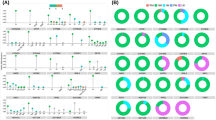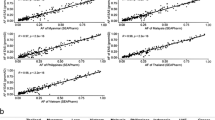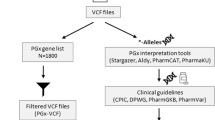Abstract
The Arabs represent one of the most genetically heterogeneous populations characterized by a high prevalence of Mendelian disorders due to consanguinity. Population-scale genomic datasets provide a unique opportunity to understand the epidemiology of variants associated with differential therapeutic response. We analyzed publicly available genomic data for 1005 Qatari individuals encompassing five subpopulations. The frequencies of known and novel pharmacogenetic variants were compared with global populations. Impact of genetic substructure on the pharmacogenetic landscape of the population was studied. We report an average of three clinically actionable pharmacogenetic variants with FDA-recommended genetic testing per Qatari individual regardless of their genetic ancestry. We observed extensive differences in the frequencies of clinically actionable pharmacogenetic variants among the Qatari subpopulations. Our analysis revealed 3579 deleterious pharmacogenetic variants potentially altering the function of 1163 genes associated with 1565 drugs. This study has thus compiled the first comprehensive landscape of pharmacogenetic variants for any Arab population.
This is a preview of subscription content, access via your institution
Access options
Subscribe to this journal
Receive 6 print issues and online access
$259.00 per year
only $43.17 per issue
Buy this article
- Purchase on Springer Link
- Instant access to full article PDF
Prices may be subject to local taxes which are calculated during checkout





Similar content being viewed by others
References
Evans WE, Relling MV. Pharmacogenomics: translating functional genomics into rational therapeutics. Science. 1999;286:487–91.
Table of Pharmacogenomic Biomarkers in Drug Labeling - FDA. https://www.fda.gov/drugs/scienceresearch/researchareas/pharmacogenetics/ucm083378.htm. Accessed 1 May 2017.
Relling MV, Klein TE. CPIC: Clinical Pharmacogenetics Implementation Consortium of the Pharmacogenomics Research Network. Clin Pharmacol Ther. 2011;89:464–7.
Ramos E, Doumatey A, Elkahloun AG, Shriner D, Huang H, Chen G, et al. Pharmacogenomics, ancestry and clinical decision making for global populations. Pharm J. 2014;14:217–22.
Wong L-P, Ong RT-H, Poh W-T, Liu X, Chen P, Li R, et al. Deep whole-genome sequencing of 100 Southeast Asian Malays. Am J Hum Genet. 2013;92:52–66.
Nagasaki M, Yasuda J, Katsuoka F, Nariai N, Kojima K, Kawai Y, et al. Rare variant discovery by deep whole-genome sequencing of 1,070 Japanese individuals. Nat Commun. 2015;6:8018.
Fakhro KA, Staudt MR, Ramstetter MD, Robay A, Malek JA, Badii R, et al. The Qatar genome: a population-specific tool for precision medicine in the Middle East. Hum Genome Var. 2016;3:16016.
Sivadas A, Salleh MZ, Teh LK, Scaria V. Genetic epidemiology of pharmacogenetic variants in South East Asian Malays using whole-genome sequences. Pharmacogenomics J. 2016. https://doi.org/10.1038/tpj.2016.39.
Giri AK, Khan NM, Grover S, Kaur I, Basu A, Tandon N, et al. Genetic epidemiology of pharmacogenetic variations in CYP2C9, CYP4F2 and VKORC1 genes associated with warfarin dosage in the Indian population. Pharmacogenomics. 2014;15:1337–54.
Giri AK, Khan NM, Basu A, Tandon N, Scaria V, Bharadwaj D. Pharmacogenetic landscape of clopidogrel in north Indians suggest distinct interpopulation differences in allele frequencies. Pharmacogenomics. 2014;15:643–53.
Shan J, Mathew R, Al-Ali K, Chouchane L. Genetic disorders in Qatar. http://www.cags.org.ae/cb408c5.pdf. Accessed 22 Sep 2017.
Hunter-Zinck H, Musharoff S, Salit J, Al-Ali KA, Chouchane L, Gohar A, et al. Population genetic structure of the people of Qatar. Am J Hum Genet. 2010;87:17–25.
Bu R, Gutiérrez MI, Al-Rasheed M, Belgaumi A, Bhatia K. Variable drug metabolism genes in Arab population. Pharm J. 2004;4:260–6.
Tanira MO, Al-Mukhaini MK, Al-Hinai AT, Al Balushi KA, Ahmed IS. Frequency of CYP2C9 genotypes among Omani patients receiving warfarin and its correlation with warfarin dose. Community Genet. 2007;10:32–7.
Djaffar-Jureidini I, Chamseddine N, Keleshian S, Naoufal R, Zahed L, Hakime N. Pharmacogenetics of coumarin dosing: prevalence of CYP2C9 and VKORC1 polymorphisms in the Lebanese population. Genet Test Mol Biomark. 2011;15:827–30.
Qumsieh RY, Ali BR, Abdulrazzaq YM, Osman O, Akawi NA, Bastaki SMA. Identification of new alleles and the determination of alleles and genotypes frequencies at the CYP2D6 gene in Emiratis. PLoS ONE. 2011;6:e28943.
Alzahrani AM, Ragia G, Hanieh H, Manolopoulos VG. Genotyping of CYP2C9 and VKORC1 in the Arabic population of Al-Ahsa, Saudi Arabia. Biomed Res Int. 2013;2013:315980.
Sivadas A, Sharma P, Scaria V. Landscape of warfarin and clopidogrel pharmacogenetic variants in Qatari population from whole exome datasets. Pharmacogenomics. 2016;17:1891–1901.
Chang CC, Chow CC, Tellier LC, Vattikuti S, Purcell SM, Lee JJ. Second-generation PLINK: rising to the challenge of larger and richer datasets. Gigascience. 2015;4:7.
Wang K, Li M, Hakonarson H. ANNOVAR: functional annotation of genetic variants from high-throughput sequencing data. Nucleic Acids Res. 2010;38:e164.
Ng PC, Henikoff S. SIFT: Predicting amino acid changes that affect protein function. Nucleic Acids Res. 2003;31:3812–4.
Adzhubei IA, Schmidt S, Peshkin L, Ramensky VE, Gerasimova A, Bork P, et al. A method and server for predicting damaging missense mutations. Nat Methods. 2010;7:248–9.
Schwarz JM, Cooper DN, Schuelke M, Seelow D. MutationTaster2: mutation prediction for the deep-sequencing age. Nat Methods. 2014;11:361–2.
Sangkuhl K, Berlin DS, Altman RB, Klein TE. PharmGKB: understanding the effects of individual genetic variants. Drug Metab Rev. 2008;40:539–51.
Wishart DS, Knox C, Guo AC, Cheng D, Shrivastava S, Tzur D, et al. DrugBank: a knowledgebase for drugs, drug actions and drug targets. Nucleic Acids Res. 2008;36:D901–6.
Danecek P, Auton A, Abecasis G, Albers CA, Banks E, DePristo MA, et al. The variant call format and VCFtools. Bioinformatics. 2011;27:2156–8.
1000 Genomes Project Consortium A, Auton A, Brooks LD, Durbin RM, Garrison EP, Kang HM, et al. A global reference for human genetic variation. Nature. 2015;526:68–74.
Lek M, Karczewski KJ, Minikel EV, Samocha KE, Banks E, Fennell T, et al. Analysis of protein-coding genetic variation in 60,706 humans. Nature. 2016;536:285–91.
Scott EM, Halees A, Itan Y, Spencer EG, He Y, Azab MA, et al. Characterization of Greater Middle Eastern genetic variation for enhanced disease gene discovery. Nat Genet. 2016;48:1071–6.
Google Sankey. https://developers.google.com/chart/interactive/docs/gallery/sankey.
R Core Team. R: A language and environment for statistical computing. Vienna: R Foundation for Statistical Computing; 2012.
Cadzow M, Boocock J, Nguyen HT, Wilcox P, Merriman TR, Black MA. A bioinformatics workflow for detecting signatures of selection in genomic data. Front Genet. 2014;5:293.
Al-Kaabi SK, Atherton A. Impact of noncommunicable diseases in the State of Qatar. Clin Outcomes Res. 2015;7:377–85.
Voight BF, Kudaravalli S, Wen X, Pritchard JK. A map of recent positive selection in the human genome. PLoS Biol. 2006;4:e72.
Weir B, Cockerham C. Estimating F-statistics for the analysis of population structure. Evolution. 1984;38:1358–1370.
Kozyra M, Ingelman-Sundberg M, Lauschke VM. Rare genetic variants in cellular transporters, metabolic enzymes, and nuclear receptors can be important determinants of interindividual differences in drug response. Genet Med. 2017;19:20–9.
Mohammed EMA. Multiple sclerosis is prominent in the Gulf states: review. Pathogenesis. 2016;3:19–38.
Sadat-Ali M, Al-Turki H, Azam M, Al-Elq A. Genetic influence on circulating vitamin D among Saudi Arabians. Saudi Med J. 2016;37:996–1001.
Barroso E, Fernandez LP, Milne RL, Pita G, Sendagorta E, Floristan U, et al. Genetic analysis of the vitamin D receptor gene in two epithelial cancers: melanoma and breast cancer case-control studies. BMC Cancer. 2008;8:385.
Naeem Z. Vitamin d deficiency-an ignored epidemic. Int J Health Sci. 2010;4:V–VI.
Lurie G, Wilkens LR, Thompson PJ, Carney ME, Palmieri RT, Pharoah PDP, et al. Vitamin D receptor rs2228570 polymorphism and invasive ovarian carcinoma risk: pooled analysis in five studies within the Ovarian Cancer Association Consortium. Int J Cancer. 2011;128:936–43.
Alagarasu K, Honap T, Mulay AP, Bachal RV, Shah PS, Cecilia D. Association of vitamin D receptor gene polymorphisms with clinical outcomes of dengue virus infection. Hum Immunol. 2012;73:1194–9.
Chen X-E, Chen P, Chen S-S, Lu J, Ma T, Shi G, et al. A population association study of vitamin D receptor gene polymorphisms and haplotypes with the risk of systemic lupus erythematosus in a Chinese population. Immunol Res. 2017;65:750–56.
Handunnetthi L, Ramagopalan SV, Ebers GC. Multiple sclerosis, vitamin D, and HLA-DRB1*15. Neurology. 2010;74:1905–10.
Vos HL. Inherited defects of coagulation factor V: the thrombotic side. J Thromb Haemost. 2006;4:35–40.
Lindqvist PG, Dahlbäck B. Carriership of factor V Leiden and evolutionary selection advantage. Curr Med Chem. 2008;15:1541–4.
Jadaon MM. Epidemiology of activated protein C resistance and factor v leiden mutation in the mediterranean region. Mediterr J Hematol Infect Dis. 2011;3:e2011037.
Acknowledgements
We acknowledge help and support from the members of Vinod Scaria Lab. We acknowledge funding from the Council of Scientific and Industrial Research (CSIR), India through the grant BSC0212 (WGP).
Author information
Authors and Affiliations
Corresponding author
Ethics declarations
Conflict of interest
The authors declare that they have no conflict of interest.
Electronic supplementary material
Rights and permissions
About this article
Cite this article
Sivadas, A., Scaria, V. Pharmacogenomic survey of Qatari populations using whole-genome and exome sequences. Pharmacogenomics J 18, 590–600 (2018). https://doi.org/10.1038/s41397-018-0022-8
Received:
Revised:
Accepted:
Published:
Issue Date:
DOI: https://doi.org/10.1038/s41397-018-0022-8
This article is cited by
-
Pharmacogenomic analysis of a genetically distinct Indigenous population
The Pharmacogenomics Journal (2022)
-
A population study of clinically actionable genetic variation affecting drug response from the Middle East
npj Genomic Medicine (2022)
-
MTHFR and F5 genetic variations have association with preeclampsia in Pakistani patients: a case control study
BMC Medical Genetics (2019)
-
Genomics of rare genetic diseases—experiences from India
Human Genomics (2019)



